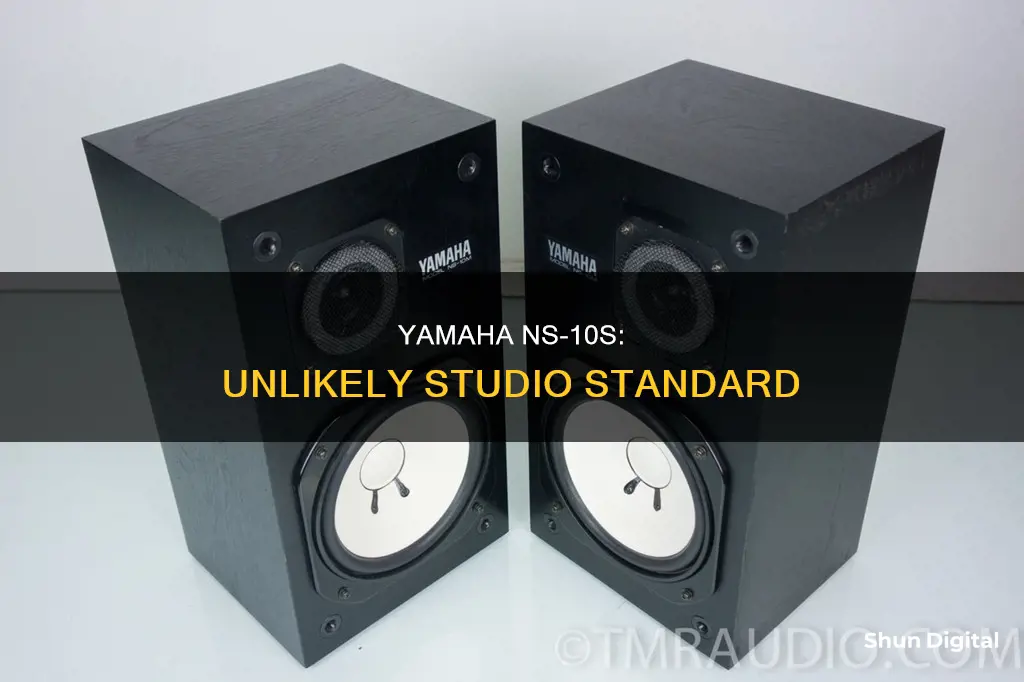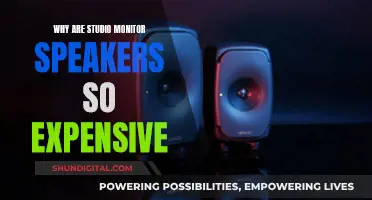
The Yamaha NS10 is a loudspeaker that became a standard near-field studio monitor in the music industry. It was designed by Akira Nakamura and launched in 1978 as a bookshelf speaker for the domestic environment. Despite being poorly received by critics and audiophiles, the NS10 soon became popular in recording studios worldwide, thanks to engineers and producers such as Greg Ladanyi, Rhett Davies, Bob Clearmountain, and Nigel Jopson. The NS10's ability to reveal shortcomings in recordings made it a valuable tool for mixing rock and pop music. Over 200,000 pairs were sold worldwide, and it earned a reputation as an industry-standard piece of equipment.
What You'll Learn
- Yamaha NS-10s were originally designed as domestic hi-fi speakers
- They were poorly received by critics and audiophiles
- The speakers became popular after Greg Ladanyi brought a pair to the US from Japan
- NS-10s reveal shortcomings in recordings
- They are known for their fast responsiveness at low frequencies

Yamaha NS-10s were originally designed as domestic hi-fi speakers
However, the NS-10 soon found a new lease of life in recording studios. The speaker was adopted by engineers and producers who valued its ability to expose any flaws in a recording. Its modest frequency range and less-than-perfect sound turned out to be its secret weapon in the studio, allowing engineers to make corrections during the production process.
The NS-10's journey from the home to the studio is often attributed to engineer Greg Ladanyi, who is said to have brought a pair of NS-10s back to the US from a trip to Japan. Ladanyi began using the speakers in a Los Angeles studio, and they soon caught the attention of other engineers. The NS-10s became particularly popular with freelance engineers, who would travel from studio to studio with their own equipment, including the now-iconic Yamaha speakers.
The NS-10s' distinctive sound and ability to reveal problem areas in mixes ensured their longevity in the studio environment. Despite their technical limitations, the speakers offered a level of honesty and accuracy that engineers trusted. The NS-10s may have been discontinued in 2001, but their influence on music production remains significant.
Best Places to Buy Marshall Monitor Headphones
You may want to see also

They were poorly received by critics and audiophiles
The Yamaha NS10 was initially designed as a domestic Hi-Fi speaker. However, it was poorly received by critics and audiophiles, and it should have faded into obscurity. The speaker was technically unremarkable and was not even Yamaha's best speaker at the time.
The NS10 was conceived as a bookshelf speaker, but it was relatively poorly received. Critics and audiophiles disliked the sound, finding it harsh, especially in the upper-midrange. It was technically unremarkable and lacked the deep immersive bass and crystal-clear highs that make something sound big.
The NS10 was mediocre, and at the time of its release, there were already superior alternatives on the market. Acoustic Research's AR18s and Mordaunt-Short's MS20s were also steadily replacing the bulkier Auratone 5Cs, which were a studio staple.
The NS10 was not an impressive speaker by any means, and it is understandable why critics and audiophiles would dismiss it. However, despite the negative reception, the NS10 would eventually become a valuable tool for mixing rock recordings and an industry standard.
Using Steam on Multiple Monitors: Customization Tips
You may want to see also

The speakers became popular after Greg Ladanyi brought a pair to the US from Japan
The Yamaha NS-10 is a loudspeaker that became a standard near-field studio monitor in the music industry. While it was originally designed as a bookshelf speaker for the domestic environment, it eventually became a valuable tool for mixing rock recordings. The speakers became popular after Greg Ladanyi brought a pair to the US from Japan.
Greg Ladanyi, a recording engineer, likely first brought the Yamaha NS-10 to American shores. Ladanyi monitored a recording session in a Japanese studio through the speaker and brought a pair back to the US. He then began using the speakers in a Los Angeles studio, where other engineers heard the NS-10 for the first time and were impressed by its sound. Its use spread to New York, where it was adopted at The Power Station and other studios.
The NS-10's popularity can be attributed to its ability to reveal shortcomings in recordings. It has a distinctive white-coloured mid-bass drive unit and is known for its ability to expose the frequencies that are the most problematic and worst-sounding to the human ear. This made it a valuable tool for recording engineers, who sought to dull its treble response by hanging tissue paper in front of it, resulting in what became known as the "'tissue paper effect'.
The NS-10's popularity was further bolstered by its use by prominent audio engineers such as Rhett Davies, Bill Scheniman, Nigel Jopson, and Bob Clearmountain. Clearmountain, a rising star in record production, is often credited for the popularity of the NS-10. He was one of the first recording engineers to hang tissue paper over the tweeters to tame the over-bright treble, resulting in a type of comb filtering. The NS-10 was used on many influential releases in the 1980s, including Roxy Music's Avalon, David Bowie's Let's Dance, and Bruce Springsteen's Born in the USA.
The speakers' popularity led to them being adopted by professional music studios, which catered to the preferences of prominent audio engineers by stocking their control rooms with the NS-10. The NS-10 became a standard near-field studio monitor, with over 200,000 pairs sold worldwide. Its influence on popular music was recognised when Yamaha won a Technical Grammy for its design in 2007, and the speaker was inducted into the Mix magazine TECnology Hall of Fame the following year.
Finding Replacement Monitor Panels: A Step-by-Step Guide
You may want to see also

NS-10s reveal shortcomings in recordings
The Yamaha NS-10s became popular in the music industry due to their ability to reveal shortcomings in recordings. The speakers were originally designed as a Hi-Fi speaker for consumers but were poorly received. However, their ability to expose sonic flaws in audio recordings was soon discovered, and they became a valuable tool for engineers and producers.
The NS-10s' unflattering sound was useful for engineers as it forced them to work harder to make their recordings sound good. The speakers' limited frequency range and prominent boost in the upper midrange of around +5 dB at 2 kHz created an open band that highlighted problematic and ugly frequencies in a mix. This made it easier for engineers to identify and fix issues in their recordings.
The NS-10s' fast transient response, due to their lightweight drivers and enclosed design, was another factor in their popularity. This responsiveness allowed for accurate balancing of bass instruments in the mix. The speakers' closed-box design and hard white cones contributed to their fast decay time in the low-frequency spectrum, resulting in a clear and balanced sound.
The NS-10s also gained a following due to their portability and familiarity. As studios became more advanced, freelance engineers benefited from having a consistent reference point by bringing their home hi-fi speakers with them. The NS-10s, being originally designed for home use, fit the bill and soon became a staple in recording studios.
The speakers' ability to reveal shortcomings in recordings was not limited to the mid-range and upper-midrange frequencies. They were also known to have excellent time-domain response at low frequencies, which was crucial for ensuring the correct balance of bass instruments in the mix.
In summary, the Yamaha NS-10s became studio standard near-field monitors due to their ability to expose flaws in recordings, their fast transient response, their portability, and their familiarity to engineers. Their unflattering sound and technical shortcomings became assets in the hands of skilled engineers, who used them to create some of the most influential recordings of the 1980s and beyond.
HRV EXL's Blind Spot Monitoring: A Comprehensive Guide
You may want to see also

They are known for their fast responsiveness at low frequencies
The Yamaha NS-10 is a loudspeaker that became a standard near-field studio monitor in the music industry. Launched in 1978, the NS-10 started as a bookshelf speaker for home use. Despite its poor reception, it eventually became a valuable tool for mixing rock recordings. The NS-10 is known for its ability to reveal shortcomings in recordings.
The NS-10's fast responsiveness at low frequencies is due to its closed-box design and hard white cones. The closed-box design and the lightweight drivers of the NS-10 contribute to its extremely fast transient response. The hard white cones, which remain still, produce sharper and more accurate transients.
A 2001 report by Newell et al. at Southampton University found that the NS-10 had an excellent time-domain response at low frequencies. Its ability to start and stop in response to signal input was superior to that of most other near-field monitors. The fast decay time in the low-frequency spectrum resulted in a clear and balanced sound of bass instruments in the mix.
The NS-10's closed-box design and fast transient response make it a valuable tool for audio engineers. Its responsiveness at low frequencies allows for accurate mixing and balancing of bass instruments in recordings.
Choosing the Right Monitor: Size Considerations
You may want to see also
Frequently asked questions
Yamaha NS10s became popular due to their ability to reveal shortcomings in recordings. They were also lightweight, portable, and provided a consistent reference point for audio engineers.
The Yamaha NS10s are known for their distinctive white bass/mid driver cone, which gives them a unique and iconic look. They also have an extremely fast transient response and an enclosed design, resulting in a clear and balanced sound.
Yamaha discontinued the production of NS10s in 2001 due to difficulties in sourcing the wood pulp needed for the low-frequency drivers.







